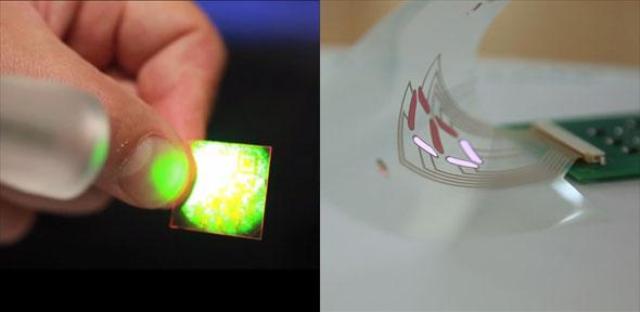Nov 6 2013
Two prototypes – a detection device which users lasers to fight fraud, and a piano which demonstrates the potential of printed electronics – have been unveiled by Cambridge researchers.
 The prototype laser detection device, which can be used to protect goods against counterfeiting. Right: Printed electronics enable flexible, digital displays which can be bent without breaking. Credit: Nick Saffell
The prototype laser detection device, which can be used to protect goods against counterfeiting. Right: Printed electronics enable flexible, digital displays which can be bent without breaking. Credit: Nick Saffell
A detection device which uses printed lasers to identify counterfeit goods has been developed by researchers, who say that it could help to make products more resistant to fraud.
The detector is one of a number of innovations covered in a new report by the Cambridge Innovation and Knowledge Centre (CIKC), which has been developing advanced manufacturing technologies for photonics and electronics.
Anti-fraud lasers
The same document also outlines a new method for printing graphene, showing how the one atom-thick material could be used to make cheap, printed electronics. Using a graphene-based ink, researchers have demonstrated this by creating a transparent, flexible piano.
The prototypes were developed within the University’s Electrical Engineering Division, and the teams are now working with partners in industry with a view to bringing them into commercial use.
Devised by a team led by Dr Damian Gardiner, the anti-fraud detector demonstrates an approach which could be employed to identify fake pharmaceuticals and currency, as well as high-value goods.
It works by exploiting an existing method for printing liquid crystal lasers with inkjet printers. This gives the user a very precise level of control over the laser’s pattern and colour combination.
The detector takes advantage of this by shining a second, laser pulse on to the printed one. It then reads the wavelength of the light emission from the printed laser through a dedicated software, and reproduces that reading as a pattern on a spectrograph.
The result is that each printed laser can be designed to give out its own, unique optical signature. Because lasers can be printed on to all sorts of surfaces – such as plastic, paper, metal and glass – the technique could be used to authenticate a wide range of products.
“Every year, hundreds of thousands of people are sold fake pharmaceuticals under the mistaken belief that they will help them, while counterfeit products cost companies hundreds of billions of pounds,” Dr Gardiner said. “We think that our printed lasers could be used to protect both products and people."
The printed piano meanwhile demonstrates the potential of using graphene in real applications where printed electronics might be needed – such as heart monitors and other sensors.
The research team behind it, Drs Tawfique Hasan, Felice Torrisi and Prof Andrea Ferrari, at the Cambridge Graphene Centre, have developed a graphene-based ink. Like the material itself, this has a number of interesting properties, including flexibility, optical transparency, and electrical conductivity.
Other conductive inks are made from precious metals such as silver, which makes them very expensive to produce and process, whereas graphene is both cheap, environmentally stable, and does not require much processing after printing. Graphene ink is also superior to conductive polymers in terms of cost, stability and performance.
The piano, designed in collaboration with Novalia Limited, shows off the graphene ink’s potential. The keys of the transparent piano are made from graphene-based inks, which have been printed on to a plastic film. These keys, working as electrodes, are connected to a simple electronic circuit-board, a battery and speaker. When a person touches a graphene electrode, the amount of electrical charge held in the key changes. This is then detected and redirected by the circuit to the speaker, creating the musical note.
The same research team, in collaboration with Printed Electronics Limited, has developed a flexible prototype digital display. This display uses conventional printable materials, but with a transparent, electrically conductive graphene layer on top. The graphene layer is not only a flexible but also more conductive and transparent than the conventional polymer it replaces. These simple displays can be used in a wide range of smart packaging applications such as toys, labelling and board games.
“Both of these devices show how graphene could be printed on to a whole range of surfaces, which makes it ideal for printed electronics,” Dr Hasan, the lead researcher behind the prototypes, said. For example, it might eventually be possible to print electronics on to clothing and to make wearable patches to monitor people with health conditions, such as a heart problem.”
Another potential application is cheap, printable sensors, which could be used to track luggage around an airport to ensure it is loaded on to the correct plane, or to follow products across a production and supply chain.
Both the laser and graphene demos were made possible with small grant funding from the CIKC, which was initially set up in January 2007 to exploit new research in electronics and photonics, and set up commercially-focused technology projects in which the researchers collaborated closely with industry. The team responsible for the first demo is now working closely with companies to take their research further, while the second team has already started a spin-off, Cambridge Graphene Platform Limited and are now developing customised inks with their industrial partners.
The CIKC report explains further how since its inception the Centre has facilitated the setting up of new companies, licencing agreements based on Cambridge research, and numerous projects linking academics and industrialists. The complete document can be downloaded for free here.
For more information about this story, please contact Tom Kirk, Tel: +44 (0)1223 332300, [email protected]